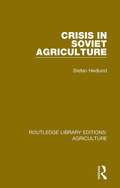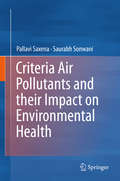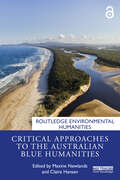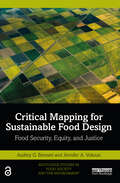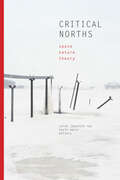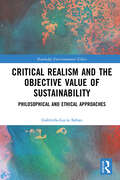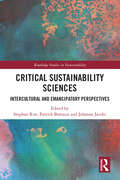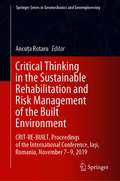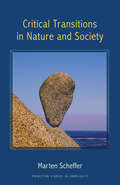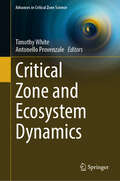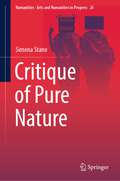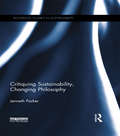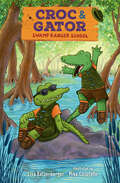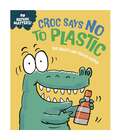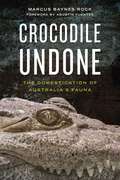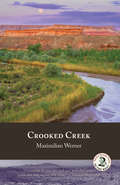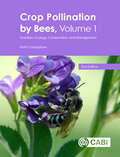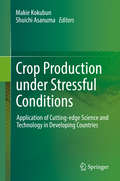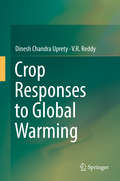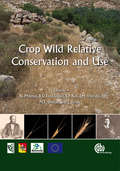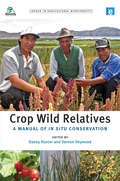- Table View
- List View
Crisis at McKinnon's Knob (Fountas & Pinnell Classroom, Guided Reading)
by Jennifer Gillis Alexander WellsNIMAC-sourced textbook. A BAD SITUATION. When two brothers find themselves in a dangerous situation while hiking, they call on survival skills they'd learned and hope those skills will be enough to save them.
Crisis in Soviet Agriculture (Routledge Library Editions: Agriculture #8)
by Stefan HedlundThis book, first published in 1984, analyses the institutions and decision-making processes that determined agricultural production in the Soviet Union. It addresses the crisis in Soviet agriculture of the early 1980s, examining the problems of low productivity, adverse natural conditions and an underdeveloped infrastructure. The book’s analysis of the ‘crisis’ focuses on the growing gap between demand and supply of agricultural produce, and the pressures on the government to alleviate the food shortages.
Criteria Air Pollutants and their Impact on Environmental Health
by Pallavi Saxena Saurabh SonwaniAir pollution is a global hazard. Majority of the world’s population is affected by air pollution. Contamination of air is no more an only an atmospheric problem but now has become a health concern too. Under the Clean Air Act of 1971, a set of air pollutants are designated as criteria pollutants. These are suspected to be strongly harming the public health and the environment as compared to other primary and secondary pollutants. Globally, this category of air pollutants has been given less attention, only few studies have been reported in this area. This book begins with a short background on criteria air pollutants and their sources, sinks and chemistry. The chapters explore the detailed nature of primary pollutants criteria pollutants such as nitrogen dioxide, sulphur dioxide, carbon monoxide, particulate matter and lead. Their reaction mechanisms, climate change potency, environmental health effects on plants and human life are discussed. The book also covers secondary pollutants such as ozone. The book discusses ozone chemistry and its environmental health effects. This book act as a valuable tool for students in Environmental Science, Biological Science and Agriculture, as well as environmental consultants and professionals involved in air quality research and the application of air quality guidelines and advice.
Critical Approaches to the Australian Blue Humanities (ISSN)
by Claire Hansen Maxine NewlandsThis interdisciplinary edited collection explores and analyses the field of the blue humanities through an Australian lens. The blue humanities is a way of understanding humanity’s relationship with water and manifestations of what is referred to as the ‘blue’ – reefs, oceans, rivers, creeks, basins, and inland bodies of water.In its scope, this collection emphasises both the importance of the local and the interconnectedness of Australia with global environmental concerns. It considers how we conceptualise watery spaces and shades of blue in a country where water is often marked by its absence, its ephemerality, its politicisation, and its dangers. Contributors from environmental history, environmental social science, political science, literary studies, creative arts, Indigenous Knowledge, education, and anthropology tackle various entanglements between the human, the more-than-human, and watery Australian spaces in modern culture. It is the first volume to offer a specific, dedicated focus on the intersections between Australian space and the blue humanities, and it offers a pathway for those wishing to explore, critique, and advance ideas around the blue humanities in both research and teaching.Directly contributing to a growing interdisciplinary field, this is the first book to comprehensively examine the blue in Australia, appealing to scholars, educators, and students working across the humanities and social sciences with an interest in the environmental humanities, ecopolitics, ecocriticism, the blue humanities, cultural geography, environmental history, and the role of place.Chapter 2 of this book is freely available as a downloadable Open Access PDF at http://www.taylorfrancis.com under a Creative Commons Attribution-Non Commercial-No Derivatives (CC-BY-NC-ND) 4.0 license.
Critical Ecologies
by Andrew BiroEnvironmental movements are the subject of increasingly rigorous political theoretical study. Can the Frankfurt School's critical frameworks be used to address ecological issues, or do environmental conflicts remain part of the "failed promise" of this group? Critical Ecologies aims to redeem the theories of major Frankfurt thinkers--Theodor Adorno, Max Horkheimer, and Herbert Marcuse, among others--by applying them to contemporary environmental crises.Critical Ecologies argues that sustainability and critical social theory have many similar goals, including resistance to different forms of domination. Like the Frankfurt School itself, the essays in this volume reflect a spirit of interdisciplinarity and draw attention to intersections between environmental, socio-political, and philosophical issues. Offering textual analyses by leading scholars in both critical theory and environmental politics, Critical Ecologies underscores the continued relevance of the Frankfurt School's ideas for addressing contemporary issues.
Critical Mapping for Sustainable Food Design: Food Security, Equity, and Justice (Routledge Studies in Food, Society and the Environment)
by Audrey G. Bennett Jennifer A. VokounThis book introduces critical mapping as a problematizing, reflective approach for analyzing systemic societal problems like food, scoping out existing solutions, and finding opportunities for sustainable design intervention. This book puts forth a framework entitled "wicked solutions" that can be applied to determine issues that designers should address to make real differences in the world and yield sustainable change. The book assesses the current role of design in attaining food security in a sustainable, equitable, and just manner. Accomplishing this goal is not simple; if it was, it would not be called a wicked problem. But this book shows how a particular repertoire of design tools can be deployed to find solutions and strategize the development of novel outcomes within a complex and interconnected terrain. To address the wicked problem of food insecurity, inequity, and injustice, this book highlights 73 peer-reviewed design outcomes that epitomize sustainable food design. This includes local and regional sustainable design outcomes funded or supported by public or private institutions and local and widespread design outcomes created by citizens. In doing so, this book sets the stage for an evidence-driven and evidence-informed design future that facilitates the designers’ visualization of wicked solutions to complex social problems, such as food insecurity. Drawing on an array of case studies from across the world, from urban rooftop farms and community cookers to mobile apps and food design cards, this book provides vitally important information about existing sustainable food design outcomes in a way that is organized, accessible, and informative. This book will be of great interest to academics and professionals working in the field of design and sustainable food systems. Students interested in learning about food and sustainability from across design studies, food studies, innovation and entrepreneurship, urban studies, and global development will also find this book of great use.
Critical Mapping for Sustainable Food Design: Food Security, Equity, and Justice (Routledge Studies in Food, Society and the Environment)
by Audrey G. Bennett Jennifer A. VokounThis book introduces critical mapping as a problematizing, reflective approach for analyzing systemic societal problems like food, scoping out existing solutions, and finding opportunities for sustainable design intervention.This book puts forth a framework entitled "wicked solutions" that can be applied to determine issues that designers should address to make real differences in the world and yield sustainable change. The book assesses the current role of design in attaining food security in a sustainable, equitable, and just manner. Accomplishing this goal is not simple; if it was, it would not be called a wicked problem. But this book shows how a particular repertoire of design tools can be deployed to find solutions and strategize the development of novel outcomes within a complex and interconnected terrain. To address the wicked problem of food insecurity, inequity, and injustice, this book highlights 73 peer-reviewed design outcomes that epitomize sustainable food design. This includes local and regional sustainable design outcomes funded or supported by public or private institutions and local and widespread design outcomes created by citizens. In doing so, this book sets the stage for an evidence-driven and evidence-informed design future that facilitates the designers’ visualization of wicked solutions to complex social problems, such as food insecurity. Drawing on an array of case studies from across the world, from urban rooftop farms and community cookers to mobile apps and food design cards, this book provides vitally important information about existing sustainable food design outcomes in a way that is organized, accessible, and informative.This book will be of great interest to academics and professionals working in the field of design and sustainable food systems. Students interested in learning about food and sustainability from across design studies, food studies, innovation and entrepreneurship, urban studies, and global development will also find this book of great use.
Critical Norths: Space, Nature, Theory
by Ray, Sarah Jaquette; Maier, KevinFor millennia, “the North” has held a powerful sway in Western culture. Long seen through contradictions—empty of life yet full of promise, populated by indigenous communities yet ripe for conquest, pristine yet marked by a long human history—it has moved to the foreground of contemporary life as the most dramatic stage for the reality of climate change. This book brings together scholars from a range of disciplines to ask key questions about the North and how we’ve conceived it—and how conceiving of it in those terms has caused us to fail the region’s human and nonhuman life. Engaging questions of space, place, indigeneity, identity, nature, the environment, justice, narrative, history, and more, it offers a crucial starting point for an essential rethinking of both the idea and the reality of the North.
Critical Realism and the Objective Value of Sustainability: Philosophical and Ethical Approaches (Routledge Environmental Ethics)
by Gabriela-Lucia SabauCritical Realism and the Objective Value of Sustainability contributes to the growing discussion surrounding the concept of sustainability, using a critical realist approach within a transdisciplinary theoretical framework to examine how sustainability objectively occurs in the natural world and in society. The book develops an ethical theory of sustainability as an objective value, rooted not in humans’ subjective preferences but in the holistic web of relationships, interdependencies, and obligations existing among living things on Earth, a web believed to have maintained life on Earth over the last 3.7 billion years. It proposes three pillars of sustainability ethics: contentment for the human existence given to us; justice (beyond distributive justice); and meaningful freedom (within ecological and moral limits). Using abductive reasoning, the book infers that there is an out-of-this-world Sustainer behind the Earth’s sustainability acting as a metaphysical source of all being and value. It argues that sustainability value, accepted as a shared understanding of the common good, must guide individual decisions and socio-economic development efforts as a matter of deliberate choice, as well as be built on the awareness that there are non-negotiable, pre-established conditions for our planet’s sustainability. This book will be of interest to students and scholars across fields of inquiry, including sustainability, sustainable development, environmental philosophy and ethics, philosophy of science, and ecological economics, and to whoever may wonder why seasons exists and why humans have creative minds.
Critical Sustainability Sciences: Intercultural and Emancipatory Perspectives (Routledge Studies in Sustainability)
by Stephan Rist Patrick Bottazzi Johanna JacobiThis book explores Critical Sustainability Sciences, a new field of scientific inquiry into sustainability issues. It builds on a highly novel integration of elements from relational ontologies, critical theory, political ecology, and intercultural philosophy in support of emancipatory perspectives on sustainability and development. The book Critical Sustainability Sciences begins by uncovering the weaknesses of mainstream sustainability science and debates on sustainable development. The new field of Critical Sustainability Sciences has grown out of a deep engagement with relational ontologies, which helps to overcome the dualist ontology underlying mainstream notions of sustainability and development. Dualist ontologies reinforce problematic anthropocentric divisions, for example, between humans and nature, subjects and objects, mind and matter, body and soul, etc. Examples from indigenous peoples in Bolivia, India, and Ghana – as well as integrative movements in Chile, Brazil, and Europe – show that relational conceptions of life, rooted in ecosophy and cosmosophy, can provide an intercultural philosophical foundation for Critical Sustainability Sciences. The book concludes by describing three key topics for exploration in Critical Sustainability Sciences: societal reorganization in view of emancipatory, existential, and cognitive self-determination; living labor and commons; and the development of new comprehensive relational scientific paradigms. This book will be of great interest to students, scholars, and practitioners of emancipatory and intercultural approaches to sustainability and development.
Critical Thinking in the Sustainable Rehabilitation and Risk Management of the Built Environment: CRIT-RE-BUILT. Proceedings of the International Conference, Iași, Romania, November 7-9, 2019 (Springer Series in Geomechanics and Geoengineering)
by Ancuța RotaruThis proceedings book presents contributions to the International Conference on Critical Thinking in the Sustainable Rehabilitation and Risk Management of the Built Environment – CRIT-RE-BUILT – held in Iași, Romania, November 7–9, 2019. It mirrors outcomes in fundamental and applied research covering a broad palette of competences like observations, analysis, interpretation, evaluation, problem-solving and decision making. The book sets up eight chapters related to rehabilitation and risk in the built environment. Each chapter starts with a broad state-of-the-art presentation comprising the latest ideas and methods in the field assessing and asserting synthesized levels of research, development and novelty through a critical thinking process. The authors of the eight presentations are partners in the E+ Programme for Strategic Partnerships Rehabilitation of the Built Environment in the Context of Smart City and Sustainable Development Concepts for Knowledge Transfer and Lifelong Learning (RE-BUILT).
Critical Transitions in Nature and Society (Princeton Studies in Complexity)
by Marten SchefferHow do we explain the remarkably abrupt changes that sometimes occur in nature and society--and can we predict why and when they happen? This book offers a comprehensive introduction to critical transitions in complex systems--the radical changes that happen at tipping points when thresholds are passed. Marten Scheffer accessibly describes the dynamical systems theory behind critical transitions, covering catastrophe theory, bifurcations, chaos, and more. He gives examples of critical transitions in lakes, oceans, terrestrial ecosystems, climate, evolution, and human societies. And he demonstrates how to deal with these transitions, offering practical guidance on how to predict tipping points, how to prevent "bad" transitions, and how to promote critical transitions that work for us and not against us. Scheffer shows the time is ripe for understanding and managing critical transitions in the vast and complex systems in which we live. This book can also serve as a textbook and includes a detailed appendix with equations.
Critical Zone and Ecosystem Dynamics (Advances in Critical Zone Science)
by Timothy White Antonello ProvenzaleThe critical zone is the thin outer veneer of continental Earth extending from the top of the vegetation canopy to subsurface depths where fresh groundwater circulates. It is the heterogeneous amalgamation of landscapes, ecosystems, and subsurface environments. The concept of the critical zone is relatively new and while thousands of manuscripts have been published from this interdisciplinary field, they exist within a wide array of journals, and none have comprehensively addressed the intersection between the geosciences and ecosystem science—“where rock meets life”. The goal of this contributed book is to promote the great potential that exists in a merger of critical zone and ecosystem science to further scientific discovery by leveraging the strengths of multiple disciplines to address societally relevant questions, keep pace with scientific advances, and more effectively engage with broader scientific communities and the public. The core readership will be collaborative researchers working at the intersection between the greater Earth, environmental and ecological sciences, and policy and business sectors that draw on science evidence to support sustainable economic development. The book also serves further readership that includes scientists from many fields, particularly those in early and mid-career stages who are interested in environmental sustainability and are seeking to step out from disciplinary research into collaborative cross-disciplinary study.
Critique of Pure Nature (Numanities - Arts and Humanities in Progress #26)
by Simona StanoThis book challenges the Western contemporary “praise for Nature”. From food to body practices, from ecological discourses to the Covid-19 pandemic, contemporary imaginaries abound with representations of an ideal “pure Nature”, essentially defined according to a logic of denial of any artificial, modified, manipulated — in short, cultural — aspect.How should we contextualise and understand such an opposition, especially in light of the rich semantic scope of the term “nature” and its variability over time? And how can we — if we actually can — envisage alternative models and approaches capable of better accounting for such richness and variability? The author addresses these fundamental issues, combining an initial theoretical problematisation of the concept of nature and its evolution — from classical philosophy to the crucial changes occurred through the Middle Ages, the Renaissance, Romanticism and the modern era, finally considering recent insights in philosophy, sociology, cultural anthropology and semiotics — with the analysis of its discursivisation — from the iconography of Mother Nature between the past and the present to the representation of catastrophic events in fictional and non-fictional texts, from clean eating and other popular food trends to the ambivalence of the naked body between its supposed natural ascription and its multiple cultural characterisations. Thus she introduces a critique of pure Nature, providing a systematic study of the way nature is attributed meaning and value in some of today’s most relevant discourses and practices, and finally tracing a possible path towards an “internatural turn”.
Critiquing Sustainability, Changing Philosophy (Routledge Studies in Sustainability)
by Jenneth ParkerTo increasing numbers of people, sustainability is the key challenge of the twenty-first century. In the many fields where it is a goal, persistent problems obstruct the efforts of those trying to make a difference. The task of this book is to provide an overview of the current state of philosophy in the context of what philosophy is, could be or should be – in relation to sustainability and the human future on Earth. The book is conceived as a contribution to the UN Decade of Education for Sustainable Development, helping to link work on philosophy and sustainability. Critiquing Sustainability, Changing Philosophy focusses on the importance of philosophical work to the formation and effectiveness of global civil society and social movements for sustainability in the context of the Anthropocene age of the Earth. It takes a transdisciplinary systems approach that challenges philosophy and concludes by proposing a greatly enhanced role for philosophy in contributing to global public reason for sustainability. This book will be of interest to philosophers, sustainability practitioners and thinkers, policy makers and all those engaged in the global movement for sustainability.
Croc & Gator 1: Swamp Ranger School
by Lisa KatzenbergerFollow no-nonsense Croc and goofball Gator as they become junior rangers in their hometown swamp!Printed entirely in green ink, these fun STEM-filled books are perfect for InvestiGators fans.Croc and Gator could not be more different, but the one thing they have in common is the love of their swamp. And now they are old enough to train as junior Swamp Rangers! They can&’t wait to learn about all the swamp&’s plants and animals, and how to protect them. When outgoing Gator and reclusive Croc are paired up, neither is sure about the other. But it turns out that their differences help them ace their tests and reward them training certificates to become the best Swamp Rangers! This great buddy series pairs two animals that kids LOVE. In their challenge to become junior rangers, Croc and Gator will need to be courageous and brave little reptiles, as they explore their swamp and prepare to protect everyone in community.With each story, readers will train alongside Croc and Gator, as they gain more experience and get badges along the way. The books will have back matter to support the theme of each story.
Croc Says No to Plastic (Nature Matters)
by Sue GravesCroc Says No to Plastic offers a gentle introduction to the concept of reducing the use of plastic for young children.In this humorous story, Croc shows her love for plastic. She loves drinks and snacks that come packaged in plastic, and she isn't very careful about throwing the plastic away after she has used it. Can she learn to reuse and recycle plastic better?This charming book is the perfect way to introduce young children to the concept of reducing the use of plastic. Also included are suggestions for activities and ideas to talk through together to help children understand the concept.The Nature Matters series of picture books provide a gentle means of promoting concepts of environmental issues, boosting self-esteem and reinforcing good behaviour. Supports the Personal, Social and Emotional Development Area of Learning in the Early Years Foundation Stage, and is also suitable for use with children in KS1 and can be used to discuss citizenship and values. Suitable for children aged 3+.
Crocodile Undone: The Domestication of Australia’s Fauna (Animalibus)
by Marcus Baynes-RockAcross the world, animals are being domesticated at an unprecedented rate and scale. But what exactly is domestication, and what does it tell us about ourselves? In this book, Marcus Baynes-Rock seeks the common thread linking stories about the domestication of Australia's native animals, arguing that domestication is part of a process by which late modernity threatens to undo the world.In a deeply personal account, the author tells of his encounters with crocodiles and emus behind fences, dingoes and kangaroos crossing boundaries, and native bees producing honey in his suburban backyard. Drawing on comparisons between Aboriginal and colonial Australians, Baynes-Rock reveals how the domestication of Australia’s fauna is a process of “unmaking.” As an extension of late modernity, the connections that tie humans and other animals to wider ecologies are being severed, threatening to isolate us and our domesticates from the rest of the world. It is here that Baynes-Rock reveals a key difference between Aboriginal and colonial Australian modes of landscape management: while one is focused on a systemic approach and sees humans as integral to ecological integrity, the other seeks to sever domesticates from ecological processes. The question that emerges is: How might we reconfigure and maintain these connections without undoing humanity?Written in the author’s characteristically frank, passionate, and humorous style, Crocodile Undone takes the reader on a journey across both physical and philosophical landscapes. This fascinating narrative will appeal to anyone interested in the vital connections between humans and animals.
Crocodile Undone: The Domestication of Australia’s Fauna (Animalibus: Of Animals and Cultures #15)
by Marcus Baynes-RockAcross the world, animals are being domesticated at an unprecedented rate and scale. But what exactly is domestication, and what does it tell us about ourselves? In this book, Marcus Baynes-Rock seeks the common thread linking stories about the domestication of Australia's native animals, arguing that domestication is part of a process by which late modernity threatens to undo the world.In a deeply personal account, the author tells of his encounters with crocodiles and emus behind fences, dingoes and kangaroos crossing boundaries, and native bees producing honey in his suburban backyard. Drawing on comparisons between Aboriginal and colonial Australians, Baynes-Rock reveals how the domestication of Australia’s fauna is a process of "unmaking." As an extension of late modernity, the connections that tie humans and other animals to wider ecologies are being severed, threatening to isolate us and our domesticates from the rest of the world. It is here that Baynes-Rock reveals a key difference between Aboriginal and colonial Australian modes of landscape management: while one is focused on a systemic approach and sees humans as integral to ecological integrity, the other seeks to sever domesticates from ecological processes. The question that emerges is: How might we reconfigure and maintain these connections without undoing humanity?Written in the author’s characteristically frank, passionate, and humorous style, Crocodile Undone takes the reader on a journey across both physical and philosophical landscapes. This fascinating narrative will appeal to anyone interested in the vital connections between humans and animals.
Crooked Creek
by Maximilian Werner2012 Eric Hoffer Book Awards for General Fiction Honorable Mention2011 Utah Book Award FinalistCrooked Creek takes place during the latter part of westward expansion and chronicles the lives (and deaths) of the Wood family. The Woods-Preston and Sara-must flee Arizona when they, along with Sara's parents and little brother Jasper, unwittingly get caught up in the plunder and sale of American Indian corpses and funerary objects. Preston, Sara, and Jasper end up in the Heber Valley of Utah, where they seek the support of Sara's Uncle Neff until they can be reunited with Sara's mother and father. But from the moment they ride into Heber, Preston and Sara learn that life in the valley is not as it appears, and that no matter how far we run, we cannot escape the past. Maximilian Werner is the author of Black River Dreams, a collection of literary fly fishing essays that won the 2008 Utah Arts Council's Original Writing Competition for Nonfiction: Book. Mr. Werner's poems, fiction, creative nonfiction, and essays have appeared in several journals and magazines, including Matter Journal: Edward Abbey Edition, Bright Lights Film Journal, The North American Review, ISLE, Weber Studies, Fly Rod and Reel, and Columbia. He lives in Salt Lake City with his wife and two children and teaches writing at the University of Utah."Maximilian Werner is a fresh and grounded writer, a welcome and original new voice." -Thomas McGuane, author of Driving on the Rim"Here in the deep measured prose of Max Werner is a western story, harsh and lush as the old world it depicts. Crooked Creek shows again that one of the natural laws of the wilderness--along with wind and stone and animals and family--is violence. Just as wind and water shaped the stone, trouble shaped these men. With its compelling, layered story, this rich book is a reader's pleasure." -Ron Carlson, author of The Signal"Max Werner's Crooked Creek offers a haunting voyage into the past and into living landscapes sharpened by western light, resonating with the work of such authors as Cormac McCarthy and Wallace Stegner. A narrative of the vitality of family bonds, it is also a tale of the heroic struggle to carry the burden of memory and to transform history's nightmares into visions of possibility, as Octavio Paz once argued was the high calling of literature. Crooked Creek reminds us of the tough aesthetic that is required to sustain hope in family, in community, and in the staggering and heartbreaking beauty of nature that Werner's prose powerfully illuminates, while also reckoning with the dark sins of betrayal and violence that are the legacies of the American West. Werner convinces us that no meaningful sense of place is possible otherwise."-George Handley, author of Home Waters: A Year of Recompenses on the Provo River
Crop Pollination by Bees, Volume 1: Evolution, Ecology, Conservation, and Management
by Dr Keith DelaplaneSince the second half of the 20th Century, our agricultural bee pollinators have faced mounting threats from ecological disturbance and pan-global movement of pathogens and parasites. At the same time, the area of pollinator-dependent crops is increasing globally with no end in sight. Never before has so much been asked of our finite pool of bee pollinators. This book not only explores the evolutionary and ecologic bases of these dynamics, it translates this knowledge into practical research-based guidance for using bees to pollinate crops. It emphasizes conserving wild bee populations as well as culturing honey bees, bumble bees, and managed solitary bees. To cover such a range of biology, theory, and practice from the perspectives of both the pollinator and the crop, the book is divided into two volumes. Volume 1 focuses on bees, their biology, coevolution with plants, foraging ecology and management, and gives practical ways to increase bee abundance and pollinating performance on the farm. Volume 2 (also available from CABI) focuses on crops, with chapters addressing crop-specific requirements and bee pollination management recommendations. Both volumes will be essential reading for farmers, horticulturists and gardeners, researchers and professionals working in insect ecology and conservation, and students of entomology and crop protection.
Crop Production under Stressful Conditions: Application of Cutting-edge Science and Technology in Developing Countries
by Makie Kokubun Shuichi AsanumaThis book presents field studies on crop production in developing countries such as Vietnam, Kenya, Namibia, Colombia, Afghanistan and Sudan. Further, it examines the achievements of SATREPS, a development assistance program sponsored by the Japanese government that promotes international joint research to address these global issues. In this context, multidisciplinary research teams consisting of breeders, physiologists, soil scientists, agronomists, and other scientists related to agricultural development worked together to tackle the challenges involved in enhancing the capacity of crop production in the respective regions. In addition to presenting novel scientific findings, this book highlights practical field studies that verify the effectiveness of the scientific findings in actual environments. The achievements will help to improve crop production worldwide, and the lessons learnt will be useful in re-designing strategies to address global issues in crop production, particularly in developing regions. Lastly, the outcomes discussed will be useful to policymakers and professionals engaged in crop production and food security in developing countries, as well as researchers and students.
Crop Responses to Global Warming
by Dinesh Chandra Uprety V. R. ReddyThe monograph entitled "Crop responses to Global warming" describes the normal historical shifts in the earth's atmospheric temperature and weighs the evidence concerning anthropogenic induced changes in the level of temperature. The unprecedented increase in the earth's temperature after pre industrial period has been possibly related to the anthropogenic activities. This monograph will give an overview of the global as well as Indian crops productivity in relation to the rise in the earth's surface temperature. A chapter in this monograph is on the technologies to study the response of crop plants to the elevated temperature. The impact assessment analysis of rising temperature on crops such as wheat, rice, maize, soybean, cotton and brassica are described, reviewed and discussed in separate chapters as case studies. The responses of physiological processes and biochemical reactions to the elevated temperature in crop plants are described crop wise. The monograph also includes the impact of elevating temperature on crop weed interaction, pest and diseases and soil dynamics for each crop species independently. The mitigation technologies to counter the adverse effect of high temperature stress are described for each crop according to their cultivation and climatic conditions. The future research strategies for each crop to meet the threat of elevating temperature on crop productivity and food security is described and discussed. The description of temperature enrichment technologies will help researchers and scientists to study the responses of biological materials to rising temperature. The monograph will be the main text for teaching climate change, global warming and environmental botany as no such book is currently available relating to the rising atmospheric temperature on crop plants. Therefore, the monograph will be highly useful for students of global climate change, environmental botany and agricultural sciences, scientists, researchers, farmers and policy makers
Crop Wild Relative Conservation and Use
by Nigel Maxted E. Dulloo J. Irinodo S. P. Keller J. Turok B. V. Ford-LloydCrop wild relatives are the natural genetic progenitors of plant species that humans cultivate and consume every day. This massive and thorough textbook covers many of the scientific efforts used to conserve and utilize these species, including in situ management, genetic and hybrid research and the prevention of natural and man-made factors that can limit or destroy crops. Specific case examples are presented from around the world, showing how agricultural science has progressed in this area, and how pollution and population growth have set this progress back. The text is dense and aimed at those already proficient at agri-science, but a more comprehensive study of crop wild relatives would be hard to imagine. Three of the six editors are affiliated with the school of biosciences, U. of Birmingham, UK; two are with Bioversity International, Rome, Italy; and one is with the U. Rey Juan Carlos, Madrid, Spain. Contributors of the 49 chapters are from many countries, and the final two chapters discuss global conservation issues.
Crop Wild Relatives: A Manual of in situ Conservation (Issues In Agricultural Biodiversity Ser.)
by Danny Hunter Vernon HeywoodCrop wild relatives (CWR) are plant species which are more or less closely related to crops. They are a vital resource by providing a pool of genetic variation that can be used in breeding new and better adapted varieties of crops that are resistant to stress, disease, drought and other factors. They will be increasingly important in allowing crops to adapt to the impacts of climate, thus safeguarding future agricultural production. Until recently, the main conservation strategy adopted for CWR has been ex situ - through the maintenance of samples as seed or vegetative material in various kinds of genebank or other facilities. Now the need to conserve CWR in their natural surroundings (in situ) is increasingly recognized. Recent research co-ordinated by Bioversity International has produced a wealth of information on good practices and lessons learned for their effective conservation. This book captures the important practical experiences of countries participating in this work and describes them for the wider conservation community. It includes case studies and examples from Armenia, Bolivia, Madagascar, Sri Lanka and Uzbekistan, which are important centres of diversity for crop wild relatives, and covers four geographical regions - the Caucasus, South America, Africa and the Asia-Pacific Region. It provides practical, relevant information and guidance for the scaling-up of actions targeting CWR conservation around the world.

